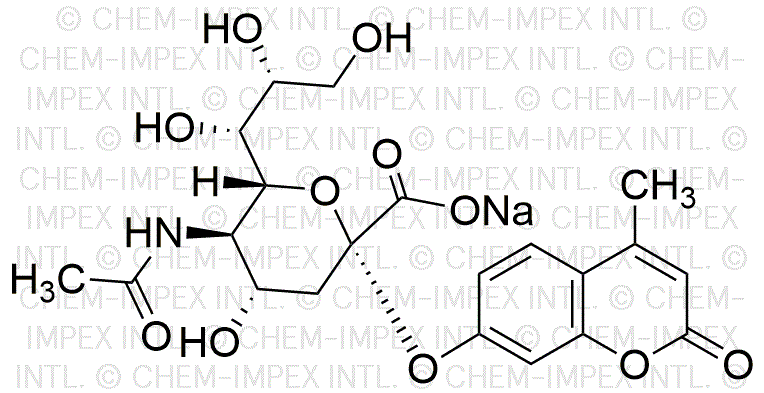2'-(4-Methylumbelliferyl)-a-D-N-acetylneuraminic acid sodium salt is widely utilized in research focused on:
- Enzyme Activity Assays: This compound serves as a substrate for sialidase enzymes, allowing researchers to measure enzyme activity in various biological samples, which is crucial for understanding metabolic pathways.
- Cell Biology: It is used in cell culture studies to investigate the role of sialic acids in cell recognition and signaling, providing insights into cellular interactions and immune responses.
- Diagnostic Applications: The compound can be employed in diagnostic kits to detect sialidase activity in clinical samples, aiding in the diagnosis of certain diseases, including viral infections.
- Biotechnology: In the field of biotechnology, it is utilized for the development of sialylated glycoproteins, which are important for vaccine development and therapeutic proteins.
- Research on Glycobiology: This chemical plays a significant role in glycobiology research, helping scientists understand the structure and function of glycoproteins and their impact on health and disease.
General Information
Properties
Safety and Regulations
Applications
2'-(4-Methylumbelliferyl)-a-D-N-acetylneuraminic acid sodium salt is widely utilized in research focused on:
- Enzyme Activity Assays: This compound serves as a substrate for sialidase enzymes, allowing researchers to measure enzyme activity in various biological samples, which is crucial for understanding metabolic pathways.
- Cell Biology: It is used in cell culture studies to investigate the role of sialic acids in cell recognition and signaling, providing insights into cellular interactions and immune responses.
- Diagnostic Applications: The compound can be employed in diagnostic kits to detect sialidase activity in clinical samples, aiding in the diagnosis of certain diseases, including viral infections.
- Biotechnology: In the field of biotechnology, it is utilized for the development of sialylated glycoproteins, which are important for vaccine development and therapeutic proteins.
- Research on Glycobiology: This chemical plays a significant role in glycobiology research, helping scientists understand the structure and function of glycoproteins and their impact on health and disease.
Documents
Safety Data Sheets (SDS)
The SDS provides comprehensive safety information on handling, storage, and disposal of the product.
Product Specification (PS)
The PS provides a comprehensive breakdown of the product’s properties, including chemical composition, physical state, purity, and storage requirements. It also details acceptable quality ranges and the product's intended applications.
Certificates of Analysis (COA)
Search for Certificates of Analysis (COA) by entering the products Lot Number. Lot and Batch Numbers can be found on a product’s label following the words ‘Lot’ or ‘Batch’.
*Catalog Number
*Lot Number
Certificates Of Origin (COO)
This COO confirms the country where the product was manufactured, and also details the materials and components used in it and whether it is derived from natural, synthetic, or other specific sources. This certificate may be required for customs, trade, and regulatory compliance.
*Catalog Number
*Lot Number
Safety Data Sheets (SDS)
The SDS provides comprehensive safety information on handling, storage, and disposal of the product.
DownloadProduct Specification (PS)
The PS provides a comprehensive breakdown of the product’s properties, including chemical composition, physical state, purity, and storage requirements. It also details acceptable quality ranges and the product's intended applications.
DownloadCertificates of Analysis (COA)
Search for Certificates of Analysis (COA) by entering the products Lot Number. Lot and Batch Numbers can be found on a product’s label following the words ‘Lot’ or ‘Batch’.
*Catalog Number
*Lot Number
Certificates Of Origin (COO)
This COO confirms the country where the product was manufactured, and also details the materials and components used in it and whether it is derived from natural, synthetic, or other specific sources. This certificate may be required for customs, trade, and regulatory compliance.


